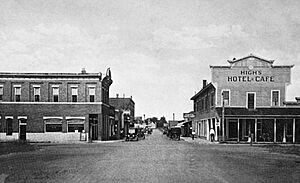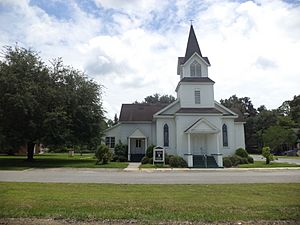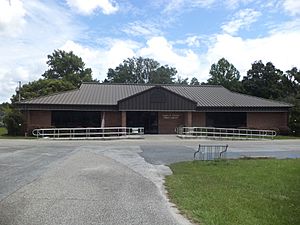Jasper, Florida facts for kids
Quick facts for kids
Jasper, Florida
|
|
|---|---|
| City of Jasper | |
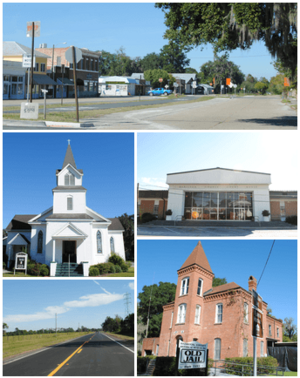
Images top, left to right: Downtown Jasper, First United Methodist Church, Hamilton County Courthouse, U.S. Route 129, Old Hamilton County Jail
|
|
| Motto(s):
"Florida's Front Porch"
|
|
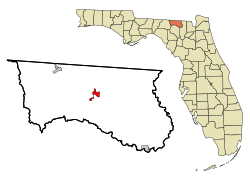
Location in Hamilton County and the state of Florida
|
|
| Country | |
| State | |
| County | Hamilton |
| Settled | 1827-1840s |
| Incorporated | March 2, 1858 |
| Named for | William Jasper |
| Government | |
| • Type | Council-Manager |
| Area | |
| • Total | 2.42 sq mi (6.26 km2) |
| • Land | 2.42 sq mi (6.26 km2) |
| • Water | 0.00 sq mi (0.00 km2) |
| Elevation | 151 ft (46 m) |
| Population
(2020)
|
|
| • Total | 3,621 |
| • Density | 1,498.76/sq mi (578.66/km2) |
| Time zone | UTC-5 (Eastern (EST)) |
| • Summer (DST) | UTC-4 (EDT) |
| ZIP code |
32052
|
| Area code(s) | 386 |
| FIPS code | 12-35375 |
| GNIS feature ID | 0284730 |
Jasper is a city in Hamilton County, Florida, United States. It is the main city, also known as the county seat, of Hamilton County. In 2020, about 3,621 people lived there.
Two important historical buildings in Jasper are listed on the National Register of Historic Places. These are the Old Hamilton County Jail and the First United Methodist Church. A major industry in the area is phosphate mining.
Contents
Jasper's Early History
People believe that Jasper was first home to the Miccosukee (Mikasukis) people. They were a group related to the Seminole nation. In 1823, the Treaty of Moultrie was signed. This treaty meant that Native American lands were bought. The Native people had to move southeast of the Suwannee River. This allowed white settlers to move into the area.
There might be an old Native burial mound near Jasper. It is located at Baisden Swamp. Also, six miles north of Jasper, there was once a Native village. It was called Halata-Micco. This village might have been home to Chief Billy Bowlegs of the Seminole. He signed the 1832 Treaty of Paynes Landing. This shows that Native people lived in the area. People often find old pottery, fishing spear points, and arrowheads there.
How Jasper Got Its Name
Soon after the 1823 treaty, Hamilton County was created. It was one of Florida's first 15 counties. Settlers from Georgia and South Carolina moved in. This happened between 1827 and the 1840s. In 1840, people called the settlement "Pulaski" or "Wall."
A man named Daniel Bell was an early settler. He became a county judge in 1828. He didn't like the names people were using for the area. So, he met with friends, including Simon Whitehurst. They decided to name the town "Jasper." This was to honor William Jasper, a hero from the Revolutionary War. The name was officially registered in Tallahassee. In 1841, the Jasper Post Office opened. On March 2, 1858, Jasper became an official town.
Growth and Changes in Jasper
Much of Jasper's early history is unclear. This is because several courthouse fires destroyed records. The first town was about a mile south of where it is now. The original courthouse was near Evergreen Cemetery. Citizens fought against Seminole raiding parties. The last Seminole War ended in 1858.
In 1861, the Civil War began. The "Jasper Blues" unit was formed from local citizens. They fought in Virginia as part of General Robert E. Lee's army. A school in Jasper was named after Lee. Today, the County School Board Offices are in that building.
In 1865, a new railway was finished. A train station was built about a mile north of the old town center. Businesses and homes moved closer to the railroad. This is how the current town of Jasper was established. The town grew a lot between 1890 and 1930. It was a busy center for turpentine, tobacco, cotton, and pine lumber. Jasper was at its busiest in the 1920s. Its population was over 2,000 people. Most of Jasper's buildings today were built during this time.
Since the 1920s, Jasper's economy has changed. Cotton gave way to turpentine, then lumber, then tobacco. Now, phosphate mining is a main industry. When Interstate 75 was built in the late 1950s, it bypassed the city. This caused the city to decline.
In 2002, city leaders expanded Jasper's boundaries. They added land near US 129 and Interstate 75. They also improved water and sewer systems. This was done to encourage new businesses to move in. Since then, new businesses have opened. A new high school was also built along this route. The population jumped between 2000 and 2010. This was because the Hamilton County Correctional Facility became part of the city.
Where is Jasper, Florida?
Jasper is in the middle of Hamilton County. It is about 90 miles west of Jacksonville. It is also 85 miles east of Tallahassee. Jasper is 32 miles southeast of Valdosta, Georgia. It is 30 miles northwest of Lake City. The city is on slightly higher land. This land is surrounded by lower areas.
U.S. Routes 41 and 129 both go through the center of Jasper. US 41 goes northwest into Georgia. It also goes southeast to White Springs. US 129 goes north to Statenville, Georgia and south to Live Oak. Interstate 75 is close to Jasper. You can get to it from Exit 451 (US 129) or Exit 460 (Florida State Road 6).
According to the U.S. Census Bureau, Jasper covers about 2.42 square miles (6.26 square kilometers). All of this area is land.
Jasper's Climate
Jasper has a humid subtropical climate. This means it has mild temperatures and hot summers. It also gets rain throughout the year.
People in Jasper
| Historical population | |||
|---|---|---|---|
| Census | Pop. | %± | |
| 1870 | 138 | — | |
| 1880 | 311 | 125.4% | |
| 1900 | 993 | — | |
| 1910 | 1,730 | 74.2% | |
| 1920 | 1,260 | −27.2% | |
| 1930 | 1,748 | 38.7% | |
| 1940 | 1,722 | −1.5% | |
| 1950 | 2,327 | 35.1% | |
| 1960 | 2,103 | −9.6% | |
| 1970 | 2,221 | 5.6% | |
| 1980 | 2,093 | −5.8% | |
| 1990 | 2,099 | 0.3% | |
| 2000 | 1,780 | −15.2% | |
| 2010 | 4,546 | 155.4% | |
| 2020 | 3,621 | −20.3% | |
| U.S. Decennial Census 1990 2000 |
|||
In 2020, the 2020 United States census counted 3,621 people living in Jasper. There were 405 households and 222 families. In 2010, the population was 4,546 people.
Education in Jasper
The Hamilton County School District runs the public schools for Jasper. These include Hamilton County Elementary School and Hamilton County High School. Both schools are located just outside the city limits.
The Suwannee River Regional Library System also operates the Jasper Public Library. It is also known as the Virginia B. Chandler Public Library.
Famous People from Jasper
- Alex J. Brown – A former NFL football player. He played for the Chicago Bears and New Orleans Saints.
- Don Bryant – A former MLB player and coach.
- Marquis Daniels – An NBA guard/forward. He played for the Milwaukee Bucks.
- Art Smith – A chef known for Southern cuisine. He often appeared on The Today Show.
- Lillian Smith – An author famous for her 1944 book Strange Fruit. She was born in Jasper.
Images for kids
See also
 In Spanish: Jasper (Florida) para niños
In Spanish: Jasper (Florida) para niños


